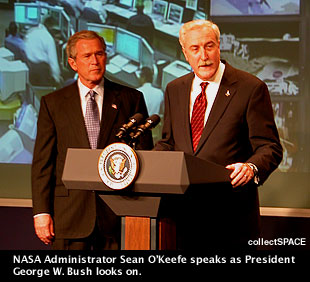|
|

|
Bush: U.S. 'headed into the cosmos'

January 14, 2004 -- President George W. Bush has committed the United States to a long-term human and robotic program to explore the solar system, starting with a return to the Moon that will ultimately enable future exploration of Mars and other destinations.
Read a transcript of the President's speech
The President's plan for space exploration is based on the following goals:
First, the United States will complete its work on the International Space Station (ISS) by 2010, fulfilling its commitment to its 15 partner countries. The U.S. will launch a re-focused research effort onboard the ISS to better understand and overcome the effects of human space flight on astronaut health, increasing the safety of future space missions.
To accomplish this goal, NASA will return the Space Shuttle to flight consistent with safety concerns and the recommendations of the Columbia Accident Investigation Board. The Shuttle's chief purpose over the next several years will be to help finish assembly of the Station, and the Shuttle will be retired by the end of this decade after nearly 30 years of service.
Second, the U.S. will begin developing a new manned exploration vehicle to explore beyond Earth orbit to other worlds -- the first of its kind since the Apollo Command Module. The new spacecraft, the Crew Exploration Vehicle (CEV), will be developed and tested by 2008 and will conduct its first manned mission no later than 2014. The CEV will also be capable of transporting astronauts and scientists to the ISS after the Shuttle is retired.
Third, the U.S. will return to the Moon as early as 2015 and no later than 2020 and use it as a stepping stone for more ambitious missions.
A series of robotic missions to the Moon, similar to the Spirit Rover that is sending images back from Mars, will explore the lunar surface beginning no later than 2008 to research and prepare for future human exploration. Using the CEV, humans will conduct extended lunar missions as early as 2015, with the goal of living and working there for increasingly extended periods.
The extended human presence on the Moon will enable astronauts to develop new technologies and harness the Moon's resources to allow manned exploration of more challenging environments. The experience and knowledge gained on the Moon will serve as a foundation for human missions beyond the Moon, beginning with Mars.
NASA will increase the use of robotic exploration to maximize the United States' understanding of the solar system and pave the way for more ambitious manned missions. Probes, landers, and similar vehicles will serve as trailblazers and send data back to scientists.
Funding added for exploration will total $12 billion over the next five years. Most of the additional funding will come from reallocation of $11 billion that is currently within the five-year total NASA budget of $86 billion.
In his 2005 budget, the President will request $1 billion to be added to NASA's existing five-year plan, or an average of $200 million per year.
From the current level of $15.4 billion, the President's proposal will increase NASA's budget by an average of 5 percent per year over the next three years, and at approximately 1 percent or less per year for the two years after those.
To ensure that NASA maintains a sense of focus and direction toward accomplishing this new mission, the President has directed NASA Administrator Sean O'Keefe to review all current space flight and exploration programs and direct them toward the President's goals.
The President also announced former Under Secretary of Defense E.C. "Pete" Aldridge, Jr. will chair a Commission on the Implementation of U.S. Space Exploration Policy to advise NASA on the long-term implementation of the President's vision.
|

© 2023 collectSPACE.com All rights reserved.
Questions? E-mail contact@collectspace.com

|
|

|

|
